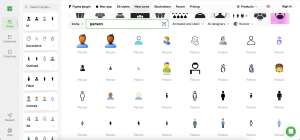Designing Person Icons: Key Considerations for Professionals
Person icons play a pivotal role in enhancing user experience by facilitating intuitive navigation and interaction within digital environments. This guide aims to provide essential considerations and strategies for designing effective person icons, utilizing tools like Icons8 to streamline the process.
Core Elements of Person Icon Design
Person icons serve various functions, from representing user profiles to signaling actions within an app. Their design should focus on visibility and immediate recognition, which are crucial for a seamless user experience. These icons are commonly integral to user interfaces, social platforms, and any digital medium requiring user representation.

Principles of Effective Design
- Simplicity: Icons should be simple enough to be understood at a glance without prior explanation.
- Consistency: A consistent design across all icons ensures a coherent user experience, reducing cognitive load and boosting usability.
- Context: Icons must be appropriate for their environment and align with the application’s overall design language and user expectations.
Technical Requirements
- Scalability: Icons should maintain clarity and effectiveness at varying sizes. Vector formats like SVG are preferred for their ability to scale without losing quality.
- Color Choices: Select colors that not only attract attention but also meet accessibility standards, such as sufficient contrast for visibility under different viewing conditions.
- File Formats: Choosing the right file format is critical. SVGs are ideal for web applications due to their scalability and performance, while PNGs might be used for their broad compatibility.
Inclusivity and Ethics
- Diversity and Representation: Icons should reflect a diverse range of personas, embracing global audiences without resorting to stereotypes. This approach not only enhances the user experience but also supports ethical design practices.
- Avoiding Stereotypes: It’s essential to use neutral and inclusive imagery that avoids reinforcing negative stereotypes or cultural biases.
Evaluation and Iteration
The design process doesn’t end with the initial release. Continual refinement through user feedback and real-world testing is crucial. This iterative process helps designers understand how icons perform in different contexts and make necessary adjustments.
Designer Tools and Enhancements
- Software and Tools: Adobe Illustrator, Sketch, and especially Icons8 offer robust features for creating and managing icon designs. Icons8 provides a comprehensive suite of tools and a vast library of customizable person icons, facilitating both the creation and management of designs.
- Icon Libraries: Utilizing pre-designed icons from Icons8 can provide a strong foundation for customization and ensure consistency and quality across projects.
Conclusion
Designing person icons is a nuanced task that requires attention to detail, technical knowledge, and an understanding of cultural factors. Leveraging resources like Icons8 can help designers create icons that are not only visually appealing but also functional and inclusive. Continuous learning and adaptation are essential to keep up with evolving technologies and user expectations, ensuring that designs remain effective and relevant.